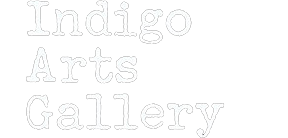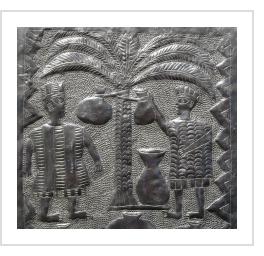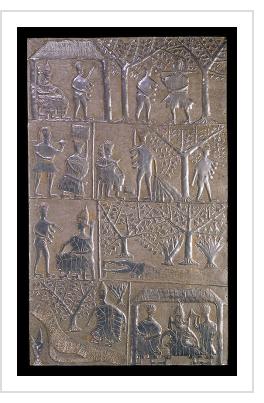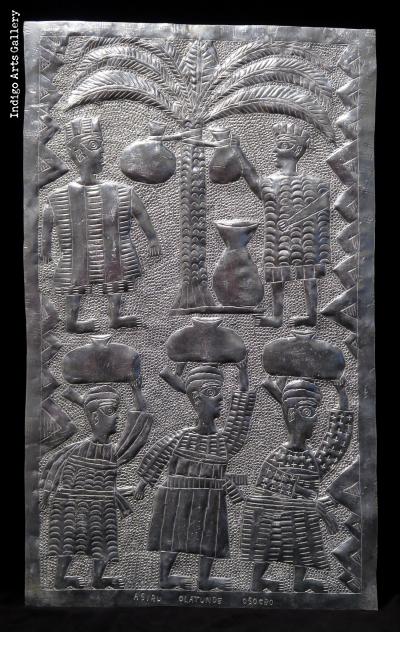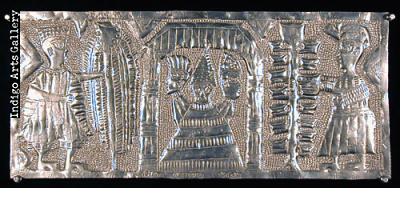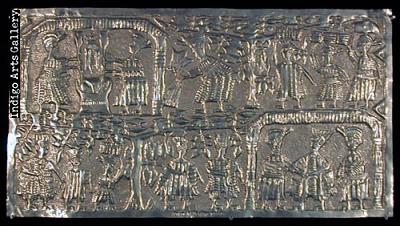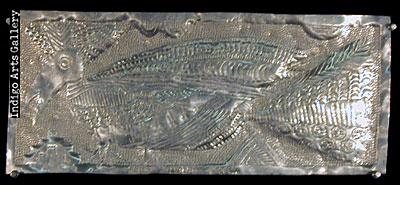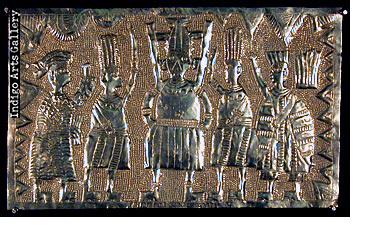About the Artist
Asiru Olatunde (1918–1993)
Like his father and grandfather before him, Asiru Olatunde (1918–1993) was a blacksmith. Illness forced him to give up blacksmithing and for a time he made jewelry to sell in the market. In 1961, encouraged by Susanne Wenger and Ulli Beier, Olatunde began to create figures of animals out of recycled copper and aluminum. His work evolved into a unique repoussé (reverse hammered technique) on aluminum panels.
These panels are studies in texture and reflected light. The overall stippling pattern recalls the white painted dots found on some traditional wooden shrine figures. Olatunde's subjects include narratives drawn from Yoruba oral tradition, Bible stories set in Nigerian settings and scenes from everyday life. One image seen repeatedly throughout his work is the tree of life, a truly universal motif that also recalls his connections to the groves of the Oshun shrine. He sold his works locally and worldwide, in both the Oshogbo market and as commissions from churches, palaces, banks and the government.
Olatunde begins by incising the fine outlines of his design with a hammer and a sharp piece of iron. Then he incises the details such as the figure's features, clothing or hair. Finally, he creates the background texture using a punch. Apprentices help with the heavier routine portions of the work.
Above information courtesy of the Smithsonian Institution National Museum of African Art.
Asiru Olatunde, Introduction by Ulli Beier
“I first met Asiru when I moved to Oshogbo in 1958. Opposite my house there was a blacksmiths’ workshop, where half a dozen craftsmen forged hoes, machetes, knives and other agricultural tools. When an important man walked past their workishop, they would use their anvils like a talking drum to recite his ‘okiri’ (poetic names) and the person so honoured would reward them with a few coins placed on their foreheads. There was a sad man sitting amongst them, who was too ill to do the strenuous work of a blacksmith. I was told that he had developed a heart disease that prevented him from pursuing the craft he had inherited from his forefathers. That was Asiru Olatunde. He was a sad, gentle person who often came to visit me and we became good friends.
Early in 1961 I discovered a little lion, cut out of thin copper plate, lying in the sand in front of my house. It was just 2 cm long and beautifully crafted. The lion’s mane, eyes and mouth had been incised into the copper. I had never seen anything similar before but Bakare Gbadamosi, a friend who helped me with Yoruba translations said: “Oh Asiru made that! When he became too ill to do the blacksmith’s work he started to make copper earrings and for a few years he made a good living from it. But then the markets became flooded with very cheap imported, gaudy jewellery and he could not sell his earrings any longer.”
I went to Asiru and said: “Look, if you can start making copper earrings again, I shall try and sell them to my friends at the University in Ibadan. Asiru began to work with enthusiasm. He made lions, leopards, cows and elephants. University staff were delighted with these little animals and for a while Asiru had a good income again. When all my friends had bought earrings, I suggested to Asiru that he would have to think of making something else. Perhaps some larger animals ? Asiru loved the challenge. He first made brooches about 5 or 6 cm long, which people could pin to their shirts. He moved on to create freestanding animals about 12 cm high. The new scale allowed him much more freedom. He could now depict two fighting leopards on the belly of a cow, or a hunter with a gun in the belly of an elephant. His work became much more complex. Soon he began to make little copper panels, about 25 cm square that depicted little stories: a hunter in the forest; a Yoruba king, sitting on his throne, surrounded by his wives. His raw materials were bits of telephone wire and copper parts of broken down cars which he melted down and then hammered out into flat sheets.
He soon became known far beyond Oshogbo and the University of Ibadan. People began to travel to Oshogbo especially to buy his work. His real breakthrough came when an architect commissioned two large panels 200 x 80 cm for a hotel in Lagos. At the time it was impossible to get such large sheets of copper in Nigeria but I discovered a factory in Lagos that manufactured aluminium. They imported huge rolls of aluminium sheeting and were willing to sell me some panels for Asiru to work on. Having completed the work for the Lagos hotel Asiru began to adopt aluminium as his favourite medium. Soon banks and business houses began to commission his aluminium panels. Priests bought them for their churches and Yoruba kings for their palaces.
Asiru began to exhibit his work in the Mbari clubs in Ibadan and Oshogbo, in the exhibition centre in Lagos and soon in Germany, England and the US. Asiru’s work appealed to all social classes. During his first exhibition in Lagos an illiterate market woman bought one of his large panels. She had never before bought a work of art. Asiru was a story teller who depicted Yoruba daily life (palm wine tappers; hunters in the forest) Yoruba mythology (the story of the woman with four breasts; the early history of Oshogbo) and Bible stories (Adam and Eve; the Creation; Jonah and the Whale and Daniel in the Lion’s Den.)
Asiru was a Muslim but then he saw no conflict between the imported religion and Yoruba tradition. At that time Islam, Christianity and Yoruba religion still co-existed peacefully in Oshogbo and there would hardly be a Christian or a Muslim who would not got to the sacred Oshun grove once a year to celebrate the foundations of Oshogbo and the pact the Ataoja (King of Oshogbo) had made with the river goddess Oshun.
Asiru’s work was not concerned with realism. His line was sensitive, the mood poetic. His repertoire was limited but his work never became stale. There was always a peaceful warmth about his work that reflected the personality of the artist himself.
Asiru was a great innovator. There was no traditional art or craft he could have learned from. He had to develop his own technique. He used the large stone anvil of the smithy to beat out his panels. He would begin by incising the outlines of the figures with a hammer and a sharp piece of iron with a flat edge. Then he cut in the details like facial features, textures patterns and so on. Finally he created the background with the help of a nail punch. This produced a fine texture made up of innumerable little circles; like an atmosphere in which the figures floated.
Many architects like Cubitts and Fry Drew and Atkinson commissioned his works so that soon he needed to train apprentices. Many of these later set themselves up as independent artists in their own right. Yekini Akamu, Salawau Iyiola, Rabiyu Adeleke, Foloronso Isola were all related to him. They were all competent craftsmen but they added few new ideas of their own.
Asiru died in 1992 aged 74 years. During the thirty six years of our friendship I have never seen him lose his temper; I never heard him speak badly about another person. He was always very calm and peaceful. He was also a very modest person. When Duro Ladipo started his Yoruba theatre company in Oshogbo, Asiru went and helped him out by playing the talking drum very competently during the early years. He was not from a drummers family and nobody knew how he had acquired this difficult skill. Asiru preceded the famous Oshogbo art movement by several years. When the Oshogbo artists created their association they elected him as their chairman. With his wisdom and calm he remained outside and above the tensions that sometimes arose between the artists. Throughout his life he was the ideal peace maker.”
Extracted from: Nigerian art: a who’s who and bibliography (1993):
276 Asiru OLATUNDE Sculptor
Address: 38 Kajola Street, PO Box 247, Oshogbo, Oshun State.
Birth: 1918, in Oshogbo, Oshun State. Died 1993
Training: Originally a blacksmith and jewelry maker, with no formal training; attended Oshogbo art workshops, Oshogbo.
Profile: Also known as Asiru; elder brother of Jinadu Oladepo and Yekini Folorunsho; father of Zaenab Oloyede Adeyemi; encouraged by Susanne Wenger and sponsored by Ulli Beier; works in aluminum and copper; maintains his own studio with apprentices who assist in finishing his repeat designs; his panels are usually narrative. First president, Oshogbo Artists Association, 1967.
Solo Exhibitions
Mbari Mbayo, Oshogbo, September 1964.
Goethe Institute, Lagos, November 1967.
Goethe Institute, Lagos, February 12-21, 1975.
"Stone and Aluminum," Portfolio, Dusseldorf‑Urdenbach, Germany, May 1976.
Goethe Institute, Lagos, 1981.
Group Exhibitions
Mbari Mbayo, Oshogbo, 1962.
Mbari Club, Ibadan and Lagos, 1963 and 1964.
Exhibition Centre, Marina, Lagos, 1964.
"Contemporary African Art," Institute of Contemporary Arts, London, December 1965.
"Treasures from the Commonwealth," Commonwealth Arts Festival, Royal Academy of Art, London, September 17‑November 13, 1965.
"Moderne Kunst aus Oshogbo," Neue Münchner Galerie, Munich, Germany, 1965; Traverse Gallery, Edinburgh, Scotland, 1967.
"Contemporary African Art," Institute of Contemporary Art, London, March 7-April 18, 1967.
Goethe Institute, Lagos, 1968.
"Contemporary African Art," Camden Arts Centre, London, August‑September 1969.
"Contemporary African Art," Otis Art Institute of Los Angeles County, Los Angeles, USA, March 13-May 4, 1969. [traveled in the USA from 1969-1973 to: Studio Museum in Harlem and New York University, New York; University of Missouri, Columbia; Cleveland Institute of Art, Cleveland; West Virginia State College, Institute; North East Missouri State College, Kirskville; Rio Hondo College, Whittier, California; Compton Community College, Compton, California; Citrus College, Azusa, California; Mira Costa College, Oceanside, California, and Civic Arts Gallery, Walnut Creek, California].
"Oshogbo Artists," Goethe Institute, Lagos, March 19-26, 1969.
"Oeuvres Africaines Nouvelles," Musée de l'Homme, Paris, France, February 13-April 13, 1970.
"Young Artists from Around the World 197l," Union Carbide Gallery, Union Carbide Building, New York, USA, April 27-May 26, 197l.
"Moderne Malerei in Afrika," Museum für Völkerkunde, Vienna, Austria, December 1970‑February 1971.
"Ten Artists from Nigeria," Arts Club of Washington, Washington DC, March 21‑ April 9, 1971.
Eighteenth Festival of the Arts, Virginia Union University, Richmond, Virginia, USA, April 18‑24, 1971.
"New African Art in Czechoslovakia," Náprstek Museum, Prague, Czechoslavakia, January‑April 1972.
"Contemporary Nigerian Art," Montgomery College, Rockville, Maryland, USA, May 1972.
"Eight Nigerian Artists," African American Institute, Washington, DC, July 1972.
The Art Society of the International Monetary Fund, Washington, DC, September 19‑October 19, 1972.
"Operation PUSH, Expo `72," PUSH Expo, Chicago, USA, September 27‑October 1, 1972.
"Africa Creates `72," Union Carbide Gallery, Union Carbide Building, New York, USA; Community Church and Inter-Church Center, New York, USA; Bedford-Stuyvesant Restoration Center, Brooklyn, USA, New York, October 1972-April 1973.
"African Art," Colorado State University, Fort Collins, Colorado, USA, February‑April 1973.
"Kauage and Asiru," New Thing Art & Architecture, Washington, DC, April 1973.
"Two Workshops/Nigeria and New Guinea," Musée d'Art Haitien, Port-au-Prince, Haiti, January l8‑February 1974.
"Art in Africa Today," Field Museum of Natural History, Chicago, April 20-November 3, 1974.
The Art Society of the International Monetary Fund, Washington, DC, May‑June 2, 1974.
"Contemporary Nigerian Art," Renwick Gallery, Washington, DC, July 25‑October 28, 1974.
"African Art," Amarillo Art Center, Amarillo, Texas, USA, February 1975.
"The Living Tradition," Dimock Gallery, George Washington University, Washington, DC, February 5‑28, 1975.
"Art‑Craft from Africa," Maryland Commission on Afro‑American and Indian History and Culture, Annapolis, Maryland, USA, November 1975.
Goethe Institute, Lagos, November 10-24, 1976.
"Moderne Kunst aus Afika," Staatlichen Kunsthalle, Berlin, Germany, June 24-August 12, 1979.
"Moderne Kunst in Afrika," Tropenmuseum, Amsterdam, The Netherlands, 1980.
"Contemporary Nigerian Artists: Ten Artists of the Oshogbo Workshops," New World Center Campus Art Gallery, Miami, USA, January 30-February 29, 1980; Metropolitan Miami-Dade Library System South Regional Library, Miami, USA, March 7-28, 1980.
"Neue Kunst in Afrika," Mainz, Germany, June 1980; Bayreuth, Germany, July-August 1980; Wörgl, Austria, September 1980.
"Oshogbo Artists," Oshogbo, July 1980.
"Twenty Years of Oshogbo Art," Goethe Institute, Lagos, ca.1981.
"Four Oshogbo Artists," Raku Gallery and Sculpture Park, Washington, DC, 1981.
"De Goden Zijn Niet Dood," Provinciehuis, Zwolle, The Netherlands, February 5-March 5, 1982.
"Oshogbo Artists from Nigeria," National Center of Afro-American Artists, Boston, USA, July 11-August 1982.
"African Art: Past and Present," Ohio State University, Columbus, Ohio, USA, May 3‑31, 1982 [and other venues in Ohio].
"Modern Art from Nigeria and Papua New Guinea from the Mbari West Collection," Mary Porter Sesnon Gallery, University of California, Santa Cruz, California, USA, November 6‑December 10, 1983.
"Contemporary African Art," National Center of Afro-American Artists, Boston, USA, December 9, 1983-January 31, 1984.
"Iwalewa: Afrikanische Kunst Heute," Städtische Galerie, Regensburg, Germany, June 9-30, 1985.
"Myth and Image: An Exhibition of Works by 14 Nigerian Artists," Denton, Texas, USA, October 15-November 10, 1985.
"Art from the African Diaspora: Becoming Visible," Aljira, Newark, New Jersey, USA, February 12-March 13, 1988.
"Contemporary Arts from Western Nigeria," Zamana Gallery, London, October 27, 1988-January 8, 1989.
"West Africa: Powerful Patterns," Kauffman Museum, Bethel College, North Newton, Kansas, USA, October 7, 1989-January 31, 1990.
"Icons: Ideals and Power in the Art of Africa," National Museum of African Art, Washington, DC, October 25, 1989-September 3, 1990.
"Reflections from Africa," Onira Arts Africa, Ottawa, Canada, April 5-20, 1990.
"Exhibition in Support of the National Policy on Population," National Museum, Lagos, April 19-30, 1990.
"Contemporary Art from Western Nigeria," Africa Centre, London, June 19-July 13, 1990.
Commissions
Aluminum repoussé panels, Ibadan University chapel, Ibadan.
Six aluminum repoussé panels, Barclays Bank, Ibadan.
Writings by the Artist
Asiru, a New Yoruba Artist; / introduced by Ulli Beier. Oshogbo: Mbari Mbayo Publications, 1965. 30pp. illus. (Oshogbo Museum Guides, no. 1.)
Public Collections
Cleveland State University, Afro-American Cultural Center, Cleveland, Ohio, USA. Aluminum counter-repoussé panel, 1971.
Council House, Johnson Wax Company, Racine, Wisconsin, USA. Aluminum panel: "An Obedient Hunter Who Turned Disobedient."
Iwalewa-Haus, Bayreuth, Germany. Aluminum repoussé panels: "Bible Stories," "Creation" "Fulani War," "God of Thunder Dancing for Him," "History of Oshogbo," "Oba and Shango-Priest Dancer," "Sango-Festival," and "Garden of Eden."
Mbari Art, Washington, DC.
Studio Museum in Harlem, New York, USA. Aluminum repoussé panel: "God of Small Pox," 1966.
University of Ibadan, Institute of African Studies, Ibadan. Aluminum repoussé panels: "Creation of the World" and "Sango".
Bibliography
Beier, Ulli & Denis Williams. "Experiment in Art Teaching," Black Orpheus (Ibadan) no. 12: 43‑47, 1961. 8 plates.
Beier, Ulli. "Nigerian Folk Art," Nigeria Magazine (Lagos) no. 75: 26‑32, December 1962. illus.
Asiru. [Details of two church doors]. In: Black Orpheus (Ibadan) no. 16, October 1964. [illus. only: plates I-IV between pages 32-33].
"New Branch for Barclays Bank at Ibadan, Nigeria," West African Builder and Architect (Lagos) 4 (6): 120-124, November-December 1964. illus.
Asiru, a New Yoruba Artist \ introduced by Ulli Beier. Oshogbo: Mbari Mbayo Publications, 1965. 30pp. illus. (Oshogbo Museum Guides, no. 1.)
Treasures from the Commonwealth: Commemorative Catalogue [of an exhibition] at the Royal Academy of Art, 17 September to 13 November 1965 / Commonwealth Arts Festival. London: Commonwealth Arts Festival Society, 1965. [55]pp., [33] leaves. illus. (some color). [None by Asiru].
Duerden, Dennis. "The London Exhibition of Contemporary African Art, 1967," African Arts (Los Angeles) 1 (1): 27‑29, 67, autumn 1967. illus. (color).
Kennedy, Jean. "Two Nigerian Artists," Nigeria Magazine (Lagos) no. 96: 2‑11, March-April 1968. illus.
Chapin, Louis. "Nigerian Art--Renaissance of the Primal," [review of an exhibition held at the Studio Museum in Harlem, New York, USA, 1970]. Christian Science Monitor (Boston) August 27, 1970.
Canaday, John. "Nigerians' Art Rewards a Pilgrimage," New York Times (New York) August 13, 1970 [and] "Not for the Airports This Time," New York Times (New York) August 16, 1970. [Reviews of exhibition of Oshogbo artists at Studio Museum in Harlem, New York, USA, 1970].
"London Art Festival," African Arts (Los Angeles) 3 (3): 20‑25, spring 1970. illus.
Young Artists from Around the World 197l; [exhibition held at the Union Carbide Gallery, Union Carbide Building, New York, USA, April 27-May 26, 197l]. New York: International Play Group, 197l. [unpaged].
Bihalji-Merin, Oto. "Afrika: Zwischen Archaik, Plebejischem Ausdruk und Naivitat," pp. 148-150, 155-158 [and] "Phantasie und Realitat aus Eisen und Zement," pp. 170-192. In the author's Die Naiven der Welt, The Hague, W. Gaade, 1972. illus.
The Art Society of the International Monetary Fund Presents Works by Asiru Olatunde, Bruce Onobrakpeya, Muraina Oyelami, September 19‑October 19, 1972 / introduction by Jean Kennedy Wolford. Washington, DC: The Art Society of the International Monetary Fund, 1972. [folder]. port.
New Thing Art & Architecture Center Invites you to the Opening of an Exhibition of Works by Asiru Olatunde [and] Kauage on April 7, 1973, Washington, DC. [Washington, DC: New Thing Art & Architecture Center, 1973. 6]pp. folder. illus.
Wahlman, Maude. "Art in Africa Today: Preview of a Forthcoming Exhibit," Field Museum of Natural History Bulletin (Chicago) 44 (8): 3‑7, September 1973. illus.
Wahlman, Maude. Contemporary African Arts. Chicago: Field Museum of Natural History, 1974. 124pp. illus. (some color). See pages 48-55.
Newman, Thelma R. Contemporary Arts and Crafts. New York: Crown Publishers, 1974. 306pp. illus. See page 244 for illustration.
Wahlman, Maude. "A Festival of Contemporary Arts," [preview of an exhibition entitled "Art in Africa Today", Field Museum of Natural History, Chicago]. African Arts (Los Angeles) 7 (3): 16‑17, 69‑71, spring 1974. illus.
Wahlman, Maude. "The Contemporary African Arts Festival," [review of an exhibition entitled "Art in Africa Today" held at the Field Museum of Natural History, Chicago, April 20-November 3, 1974]. Field Museum of Natural History Bulletin (Chicago) 45 (4): 3‑8, April 1974. illus. (color).
Armstrong, Robert Plant. "Art in Africa Today," [review of an exhibition held at the Field Museum of Natural History, Chicago, April 20-November 3, 1974]. African Arts (Los Angeles) 7 (4): 72‑74, summer 1974. illus.
Beier, Ulli. The Return of the Gods: The Sacred Art of Susanne Wenger. Cambridge: Cambridge University Press, 1975. See pages 22-23.
Beier, Ulli. "Asiru Olatunde," pp. 97‑98. In: Modern Konst i Afrika: Modern Art in Africa, Lund, Sweden, Kalejdoskop, 1978. illus. (color).
Beier, Georgina. "Oshogbo," pp. 117‑129. In: Neue Kunst in Afrika, Berlin, Reimer, 1980. illus.
"Asiru Olatunde," p. 58. In: The Council House: The International Conference Center of S. C. Johnson and Son, Racine, Wisconsin / edited by Lee Nordness. [s.l.]: Perimeter Press, 1980. illus. (color), port.
Povey, John F. "The African Artist in a Traditional Society," Ba Shiru (Madison) 11 (1): 3‑8, 1980.
Contemporary Nigerian Artists: Ten Artists of the Oshogbo Workshop; [exhibition held at New World Center Campus Art Gallery, Miami, USA, January 30-February 29, 1980 and Metropolitan Miami-Dade Library System South Regional Library, Miami, USA, March 7-28, 1980] / text by Roberta Griffin. Miami: Miami-Dade Community College, 1980. [4]pp.
Aiyetan, Dayo. "Osogbo Artists in a Rebirth," Daily Sketch (Ibadan) August 30, 1980.
Four Oshogbo Artists; [exhibition held at the Raku Gallery and Sculpture Park, Washington, DC, 1981]. Washington, DC: Raku Gallery, 1981. [folder].
Modern Art From Nigeria and Papua New Guinea from the Mbari West Collection; [exhibition held at the Mary Porter Sesnon Gallery, University of California, Santa Cruz, California, November 6‑December 10, 1983] / foreword by Jean Kennedy. [s.l.: s.n.], 1983. [8]pp. illus.
Ojo, Albert O. "The Contributions of Contemporary Artists in Nigerian Sculpture, pp. 87-108. In the author's The Role of Art in Promoting Cultural Heritage and Art Education in Nigeria: A Pedagogical Assemblage, PhD dissertation, Columbia University, 1984, Ann Arbor, University Microfilms International, 1985. 306pp. illus., bibliog.
Pruitt, Sharon Yvette. "Kuntu Sculpture from the 1950s to 1982," pp. 66-119. In: Perspectives in the Study of Nigerian Kuntu Art: A Traditionalist Style in Contemporary African Visual Expression, PhD dissertation, Ohio State University, 1985, Ann Arbor, University Microfilms International, 1985. See pages 556-564 for interview.
Scott, Victoria. Myth and Image: A Collection of work by 14 Nigerian Artists of the Oshogbo School on Loan from Victoria Scott of New York; [exhibition held in Denton, Texas, October-November 1985. Denton, Texas]: Greater Denton Arts Council, 1985. [13]pp. illus. [None by Olatunde].
Soppelsa, Robert T. "West Africa: Powerful Patterns," [review of an exhibition held at the Kauffman Museum, Bethel College, North Newton, Kansas, October 7, 1989-January 31, 1990]. African Arts (Los Angeles) 23 (4): 83, October 1990. illus. [None by Asiru].
Shitta, Hakeem O. "A Betrayed & Neglected Pioneer Artist: Ashiru Olatunde," Arts Illustrated Weekly (Lagos) no. 37: 1, December 20-26, 1990. illus.
See also references: 4, 27, 29, 45, 56-57, 64, 83, 96, 100, 105, 107, 118-120, 122, 138, 142-143, 174, 184, 186, 191, 193, 206, 212, 234-237, 240a, 250, 253-254, 258, 263-266, 272-273, 281, 287, 309, 314, 317-319.
